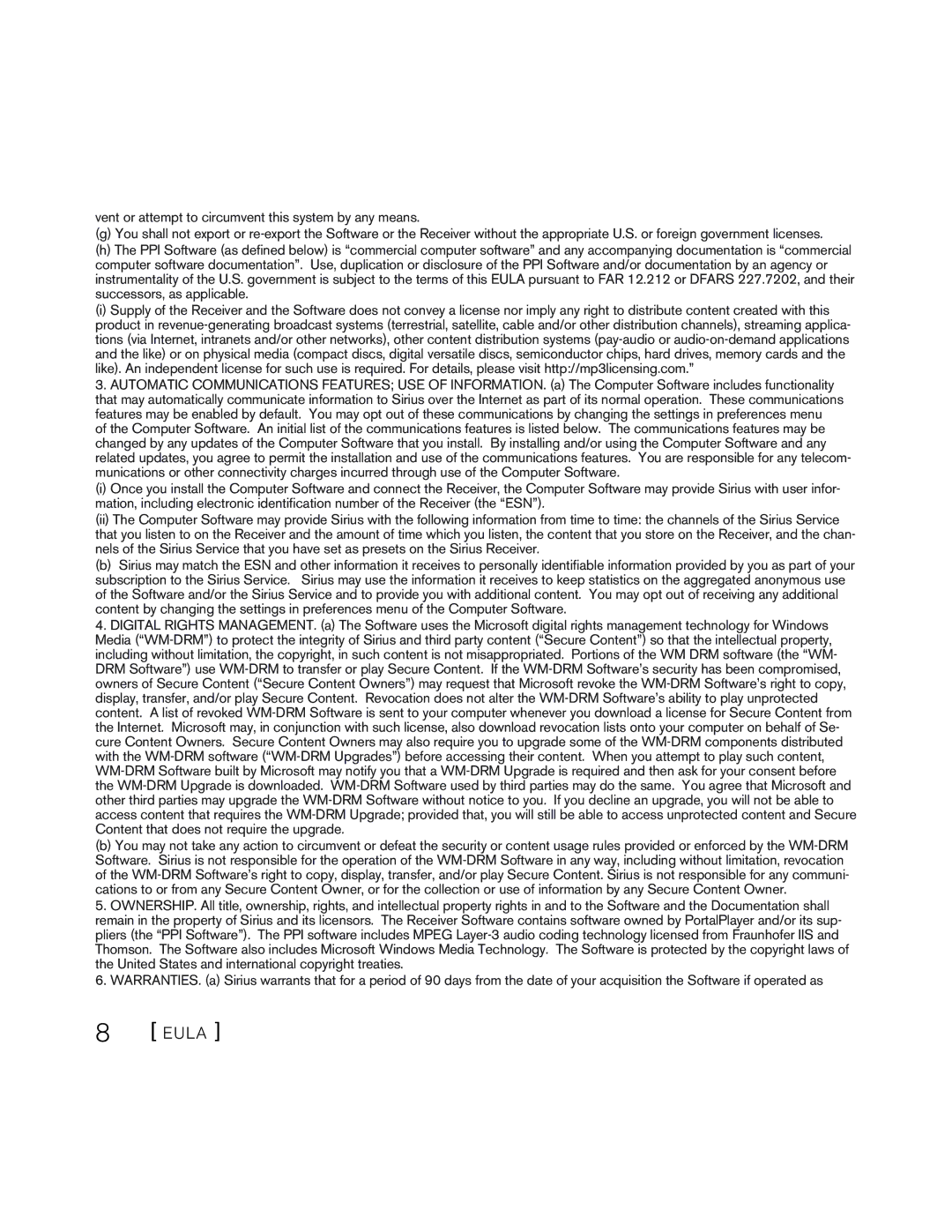vent or attempt to circumvent this system by any means.
(g)You shall not export or re-export the Software or the Receiver without the appropriate U.S. or foreign government licenses.
(h)The PPI Software (as defined below) is “commercial computer software” and any accompanying documentation is “commercial computer software documentation”. Use, duplication or disclosure of the PPI Software and/or documentation by an agency or instrumentality of the U.S. government is subject to the terms of this EULA pursuant to FAR 12.212 or DFARS 227.7202, and their successors, as applicable.
(i)Supply of the Receiver and the Software does not convey a license nor imply any right to distribute content created with this product in revenue-generating broadcast systems (terrestrial, satellite, cable and/or other distribution channels), streaming applica- tions (via Internet, intranets and/or other networks), other content distribution systems (pay-audio or audio-on-demand applications and the like) or on physical media (compact discs, digital versatile discs, semiconductor chips, hard drives, memory cards and the like). An independent license for such use is required. For details, please visit http://mp3licensing.com.”
3. AUTOMATIC COMMUNICATIONS FEATURES; USE OF INFORMATION. (a) The Computer Software includes functionality that may automatically communicate information to Sirius over the Internet as part of its normal operation. These communications features may be enabled by default. You may opt out of these communications by changing the settings in preferences menu of the Computer Software. An initial list of the communications features is listed below. The communications features may be changed by any updates of the Computer Software that you install. By installing and/or using the Computer Software and any related updates, you agree to permit the installation and use of the communications features. You are responsible for any telecom- munications or other connectivity charges incurred through use of the Computer Software.
(i)Once you install the Computer Software and connect the Receiver, the Computer Software may provide Sirius with user infor- mation, including electronic identification number of the Receiver (the “ESN”).
(ii)The Computer Software may provide Sirius with the following information from time to time: the channels of the Sirius Service that you listen to on the Receiver and the amount of time which you listen, the content that you store on the Receiver, and the chan- nels of the Sirius Service that you have set as presets on the Sirius Receiver.
(b)Sirius may match the ESN and other information it receives to personally identifiable information provided by you as part of your subscription to the Sirius Service. Sirius may use the information it receives to keep statistics on the aggregated anonymous use of the Software and/or the Sirius Service and to provide you with additional content. You may opt out of receiving any additional content by changing the settings in preferences menu of the Computer Software.
4. DIGITAL RIGHTS MANAGEMENT. (a) The Software uses the Microsoft digital rights management technology for Windows Media (“WM-DRM”) to protect the integrity of Sirius and third party content (“Secure Content”) so that the intellectual property, including without limitation, the copyright, in such content is not misappropriated. Portions of the WM DRM software (the “WM- DRM Software”) use WM-DRM to transfer or play Secure Content. If the WM-DRM Software’s security has been compromised, owners of Secure Content (“Secure Content Owners”) may request that Microsoft revoke the WM-DRM Software’s right to copy, display, transfer, and/or play Secure Content. Revocation does not alter the WM-DRM Software’s ability to play unprotected content. A list of revoked WM-DRM Software is sent to your computer whenever you download a license for Secure Content from the Internet. Microsoft may, in conjunction with such license, also download revocation lists onto your computer on behalf of Se- cure Content Owners. Secure Content Owners may also require you to upgrade some of the WM-DRM components distributed with the WM-DRM software (“WM-DRM Upgrades”) before accessing their content. When you attempt to play such content, WM-DRM Software built by Microsoft may notify you that a WM-DRM Upgrade is required and then ask for your consent before the WM-DRM Upgrade is downloaded. WM-DRM Software used by third parties may do the same. You agree that Microsoft and other third parties may upgrade the WM-DRM Software without notice to you. If you decline an upgrade, you will not be able to access content that requires the WM-DRM Upgrade; provided that, you will still be able to access unprotected content and Secure Content that does not require the upgrade.
(b)You may not take any action to circumvent or defeat the security or content usage rules provided or enforced by the WM-DRM Software. Sirius is not responsible for the operation of the WM-DRM Software in any way, including without limitation, revocation of the WM-DRM Software’s right to copy, display, transfer, and/or play Secure Content. Sirius is not responsible for any communi- cations to or from any Secure Content Owner, or for the collection or use of information by any Secure Content Owner.
5. OWNERSHIP. All title, ownership, rights, and intellectual property rights in and to the Software and the Documentation shall remain in the property of Sirius and its licensors. The Receiver Software contains software owned by PortalPlayer and/or its sup- pliers (the “PPI Software”). The PPI software includes MPEG Layer-3 audio coding technology licensed from Fraunhofer IIS and Thomson. The Software also includes Microsoft Windows Media Technology. The Software is protected by the copyright laws of the United States and international copyright treaties.
6. WARRANTIES. (a) Sirius warrants that for a period of 90 days from the date of your acquisition the Software if operated as
